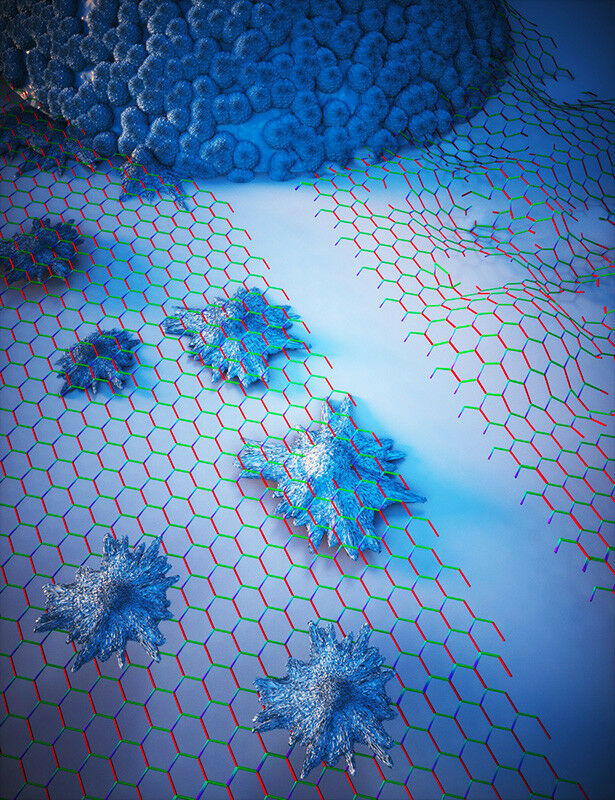博文
早期诊断转移的第一步
 精选
精选
||
早期诊断转移的第一步
诸平
Stiff basement membranes promote metastasis Image: Ella Maru Studios.
据德国弗莱堡大学(University of Freiburg)2024年3月4日提供的消息,德国和丹麦的研究小组开发了一种新的分析人类肺部基底膜(basement membrane in human lungs)的方法,是迈向早期诊断转移的第一步(First Step Toward Early Diagnosis of Metastasis)。
转移是造成实体癌患者死亡率的主要原因;如果诊断为转移,癌症患者的预后会显著降低。到目前为止,还没有可靠的方法来预测未来转移的可能性。
由弗莱堡大学医学院(Medical Faculty, University of Freiburg, Freiburg, Germany)的初级教授拉斐尔·鲁特(Raphael Reuten)博士和德国慕尼黑应用科学大学(Munich University of Applied Sciences, HM)的豪克·克劳森-绍曼(Hauke Clausen-Schaumann)教授领导的来自丹麦和德国的科学家团队,现在已经迈出了早期诊断转移形成的第一步:他们开发了一种用户友好的方法来分析人体基底膜-因为它的机械性能是转移过程中的关键因素。相关研究结果于2024年3月1日已经在著名的科学杂志《自然协议》(Nature Protocols)网站发表——Bastian Hartmann, Lutz Fleischhauer, Monica Nicolau, Thomas Hartvig Lindkær Jensen, Florin-Andrei Taran, Hauke Clausen-Schaumann, Raphael Reuten. Profiling native pulmonary basement membrane stiffness using atomic force microscopy. Nature Protocols, 2024. DOI: 10.1038/s41596-024-00955-7. Published: 01 March 2024. https://www.nature.com/articles/s41596-024-00955-7
参与此项研究的除了来自弗莱堡大学和慕尼黑应用科学大学的研究人员之外,还有来自德国慕尼黑的纳米科学中心(Center for Nanoscience, Munich, Germany)、丹麦哥本哈根大学(University of Copenhagen, Copenhagen, Denmark)、丹麦哥本哈根的医院(Rigshospitalet, Copenhagen, Denmark)的研究人员。
较软的基底膜更难克服(Softer basement membranes are harder to overcome)
拉斐尔·鲁特说:“我们相信,以详细方案的形式发表这种方法将使我们更接近于转移形成的早期诊断。”使用该方案,世界各地的科学家将能够确定不同的个体是否具有不同的基底膜力学,以及这些力学是否与转移形成有关。基底膜是细胞外基质(细胞外的蛋白质团)的一种结构,它包围着所有的血管、许多器官和肿瘤。
过去,人们认为这种结构只是癌细胞必须借助自身机制克服的屏障。然而,拉斐尔·鲁特和豪克·克劳森-绍曼在2021年的一篇论文中(in a paper from 2021)表明,基底膜的力学特性本身是影响癌细胞转移的决定性因素,因此也是影响癌症患者预后的决定性因素:基底膜越软,癌细胞越少,从而减少转移,延长生存期。
半自动化软件分析(Analysis by semi-automated software)
科学家们与弗莱堡大学医学中心的妇产科(The University Medical Center Freiburg’s obstetrics and gynecology clinic)和哥本哈根医院(Rigshospitalet)的病理部一起,以详细和方便用户的步骤指南的形式发表了如何确定人体肺基底膜的机械特性的分析工具。该团队还开发了用于分析测量数据和鉴定基底膜的半自动软件,供科学界使用。随着人工智能的发展,这个软件在未来会变得更加强大。上述研究论文的第一作者、来自慕尼黑应用科学大学(HM)的巴斯蒂安·哈特曼(Bastian Hartmann)说:“一旦有了更全面的数据,就可以利用机器学习实现对基底膜的全自动识别。”
基底膜的厚度只有100~400 nm。生物物理学家豪克·克劳森-绍曼说:“精确定位它在组织中的位置,测量它的机械性能,并从周围组织中精确地识别它本身就是一个特殊的挑战。我们能够通过光学显微镜和原子力显微镜的结合来解决这个问题。”新方案现在将这一程序扩展到包括人类肺基底膜,使其对没有经验的用户可行。
癌症研究的其他发现(Additional findings for cancer research)
科学家们期待用他们的方法获得癌症研究的重要发现。这是因为尽管肿瘤重塑了体内的许多结构以满足其需求,但独立于这些与癌症相关的变化之外,基底膜的个体力学特性对转移过程具有至关重要的影响。因此,拉斐尔·鲁特推测,基底膜的某些机制原则上可能使某些人更容易发生转移。
拉斐尔·鲁特博士自2021年年中以来一直担任弗莱堡大学实验与临床药理学和毒理学研究所(The University of Freiburg’s Institute of Experimental and Clinical Pharmacology and Toxicology)的初级教授,并领导着MateriTecture Lab研究小组。他的研究重点是细胞外结构对细胞过程的影响,特别是肿瘤的进展,目的是将基于基质的诊断和治疗策略应用于日常临床应用。
豪克·克劳森-绍曼教授在慕尼黑应用科学大学应用组织工程和再生医学中心(Munich University of Applied Sciences’ Center for Applied Tissue Engineering and Regenerative Medicine)进行研究工作。他的专长是在纳米尺度上识别生物材料的机械特性。巴斯蒂安·哈特曼是豪克·克劳森-绍曼研究组的博士生,主要研究利用原子力显微镜对组织进行纳米力学研究。
本研究得到了德国巴伐利亚州科学和艺术部通过巴伐利亚研究中心(CANTER)和巴伐利亚学术论坛(BayWISS)健康研究博士联盟{ Bavarian State Ministry of Science and the Arts through the Bavarian Research Focus ‘Herstellung und biophysikalische Charakterisierung von dreidimensionalen Geweben (CANTER)’ and the Bavarian Academic Forum (BayWISS)—Doctoral Consortium ‘Health Research’}提供的资金。也得到了来自德国研究基金会(German Research Foundation)和丹麦癌症协会(Danish Cancer Society R204-A12454)的资助。
上述介绍,仅供参考。欲了解更多信息,敬请注意浏览原文或者相关报道。
Mammalian cells sense and react to the mechanics of their immediate microenvironment. Therefore, the characterization of the biomechanical properties of tissues with high spatial resolution provides valuable insights into a broad variety of developmental, homeostatic and pathological processes within living organisms. The biomechanical properties of the basement membrane (BM), an extracellular matrix (ECM) substructure measuring only ~100–400 nm across, are, among other things, pivotal to tumor progression and metastasis formation. Although the precise assignment of the Young’s modulus E of such a thin ECM substructure especially in between two cell layers is still challenging, biomechanical data of the BM can provide information of eminent diagnostic potential. Here we present a detailed protocol to quantify the elastic modulus of the BM in murine and human lung tissue, which is one of the major organs prone to metastasis. This protocol describes a streamlined workflow to determine the Young’s modulus E of the BM between the endothelial and epithelial cell layers shaping the alveolar wall in lung tissues using atomic force microscopy (AFM). Our step-by-step protocol provides instructions for murine and human lung tissue extraction, inflation of these tissues with cryogenic cutting medium, freezing and cryosectioning of the tissue samples, and AFM force-map recording. In addition, it guides the reader through a semi-automatic data analysis procedure to identify the pulmonary BM and extract its Young’s modulus E using an in-house tailored user-friendly AFM data analysis software, the Center for Applied Tissue Engineering and Regenerative Medicine processing toolbox, which enables automatic loading of the recorded force maps, conversion of the force versus piezo-extension curves to force versus indentation curves, calculation of Young’s moduli and generation of Young’s modulus maps, where the pulmonary BM can be identified using a semi-automatic spatial filtering tool. The entire protocol takes 1–2 d.
https://wap.sciencenet.cn/blog-212210-1424079.html
上一篇:创新的癌症治疗使用超声激活药物靶向
下一篇:AIP:中国月球样本中的硅土揭示了月球隐藏的历史
